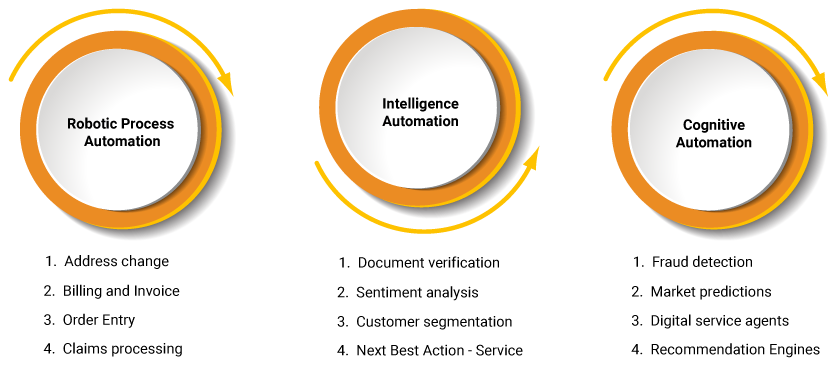From Robotic Process Automation (RPA) to Intelligent Automation (IA)
Get in touch now!
Robotic Process Automation (RPA) to Intelligent Automation (IA)
Get in touch now!
From Robotic Process Automation (RPA) to Intelligent Automation (IA)
Robotic process automation has evolved significantly over recent years. When applied with systematic planning, RPA substantially improves performance and reduces the cost of operations. Most enterprise processes are manual, deterministic, and repetitive, and more than 70% can be automated using software robots. Processes that have greater complexity and require human judgment can also be automated by 15–20% through strong collaboration between software robots and human workers. As per one of the studies by HfS:
-
98% of enterprises have an automation agenda at various adoption stages
-
4 out of 5 C-suites are placing AUTOMATION as their #1 strategic priority for operations
-
52% seek the better quality of operations, 49% seek more workforce agility and scalability, 48% seek superior data accuracy
Yet, the same analyst report also mentions one key statistic:
-
>40% leaders are either moderately satisfied or not satisfied with their RPA programs
Why is that?
Let’s explore the shortcomings of RPA
RPA starting point does not match Business Reality

Rules Based

Repetitive & Mechanical

Structured Data
Business Reality

Even the simplest of the processes may have cognitive elements

Not all processes are automation ready

Many of the processes deal with semi-structured and unstructured data, speech

Many data elements & processes are non-standardized

Enterprise-wide end-to-end automation needs several jig saw pieces
RPA Myths are now busted
RPA is the answer to all manual pains
RPA is about the tool-set
Implement RPA for cost reduction
RPA is the holy grail
Intelligent Automation for End-to-End value

Intelligent Process Automation
Gartner predicts that “by 2020, end-user spending on robotic process automation software will reach $1 billion, growing at a compound annual growth rate (CAGR) of 41% from 2015 through 2020.” The forecast says that “by 2020, RPA tools will have evolved to include more types of functionality, such as AI software, but will experience strong downward pricing pressure.”
Investing in RPA

Overall cost reduction

Speed and productivity

Accuracy and compliance

Scalability and flexibility

Removal of non-value-add processes
The Future Beyond RPA
As the benefits of RPA adoption continue to grow, greater numbers of organizations are beginning their own deployments. However, as RPA is still subject to much speculation, businesses need a well-designed strategy to pivot from boardroom conversations to actual success. Directed systematically, RPA adoption is paving the way to achieving the cost and operational efficiencies desired by most organizations.
Check out our recorded webinar on:
-
Why you should move from RPA to Intelligent Automation?
-
What RPA cannot do?
-
How to solve challenges to and drive maximum business results by combining RPA with NLP/ Artificial Intelligence/Machine Learning?
The 3 Big questions
What is RPA versus Machine Learning versus Artificial Intelligence?
RPA is a software that enables automation of human-intensive data-centric activities by leveraging the user interface of existing applications. “Bot” is the term used to refer the software that automates the tasks. We can run the Bots either on operator desktops or remotely.
Machine Learning is a programmatic approach to building algorithmic models using statistical principles, to solve data-centric tasks such as classification, grouping, prediction and association. When we use Machine learning to automate the tasks, we refer to it as “Intelligent Automation”.
AI deals with sophisticated learning and prediction systems, trained to automate the desired tasks. The major evolution in AI as compared to Machine learning is the use of concepts like neural networks to build models inductively. Essentially, we are creating a learning engine that learns from the vast number of inputs and outputs to start predicting the outcomes. Over a period of training, the AI engine starts to provide outcomes even when we have not provided all inputs or the training dataset does not have a matching input-output combination. “Cognitive Automation” refers to automation of tasks leveraging the AI capabilities.
What types of problems do RPA, ML and AI address have?
This is a difficult question to answer mainly because the automation and analytics space is fast evolving with many new terms introduced recently. Every person we speak to might have a different answer depending on his or her experience and background. Let us consider the two dimensions that primarily dictate the automation space: viz. Data and Process.

In the above diagram, The X-axis and Y-axis represent the Data and Process dimensions respectively. The process axis varies from structured to unstructured scale. The Data axis varies on the structure and volume of input variables. The above graph represents a spectrum for automation, which begins with RPA and moves up into intelligent automation and then cognitive automation. The below table describes each of these domains.

Above table provides a view of delineation between RPA, Intelligent and Cognitive automation.
What are the use cases for applying RPA, Machine Learning & AI?
The capabilities offered by RPA, Intelligent Automation (Machine Learning) and Cognitive [] Automation (AI) address different categories of problems based on the value proposition offered by each. I have shared a few sample use cases across the automation spectrum in the below diagram.
